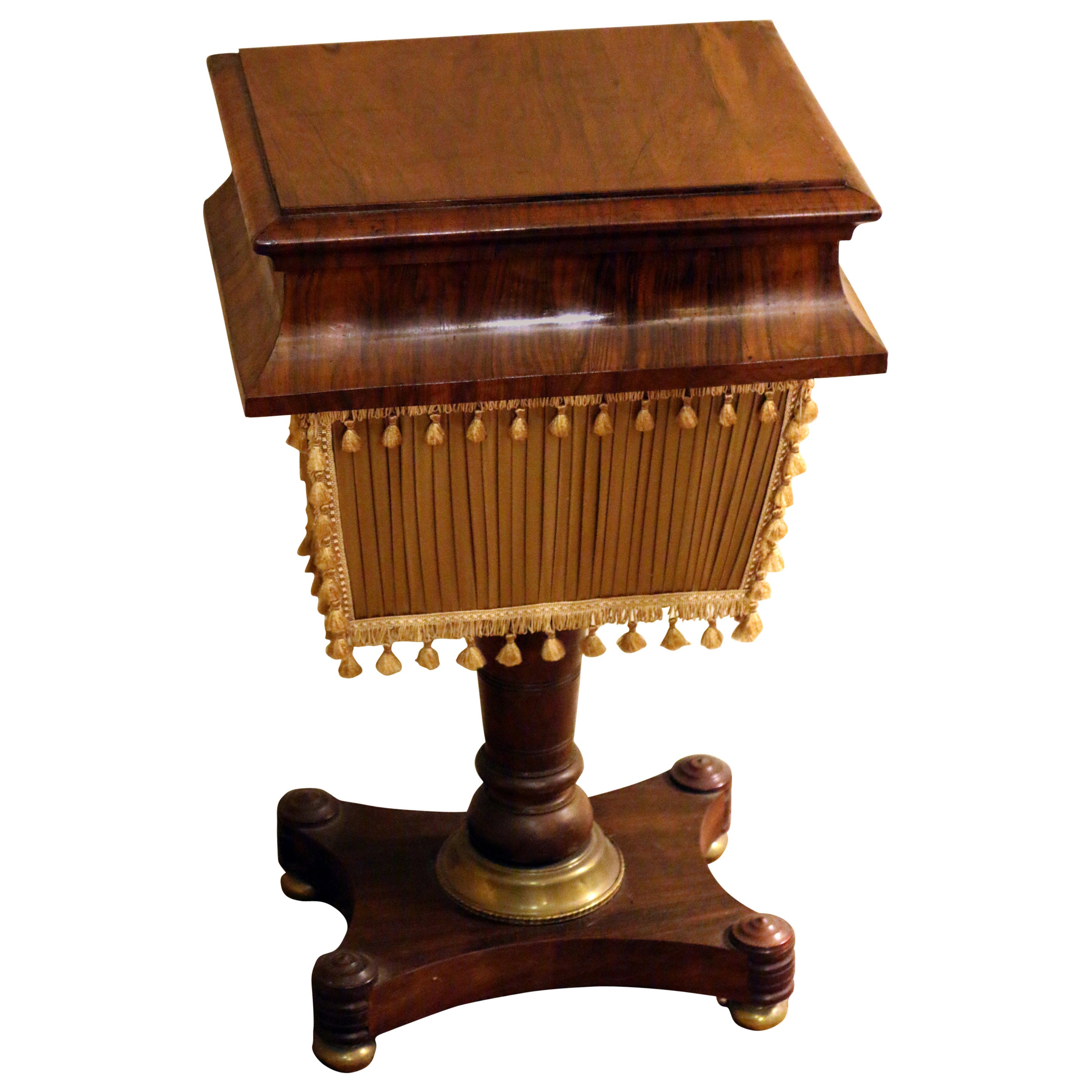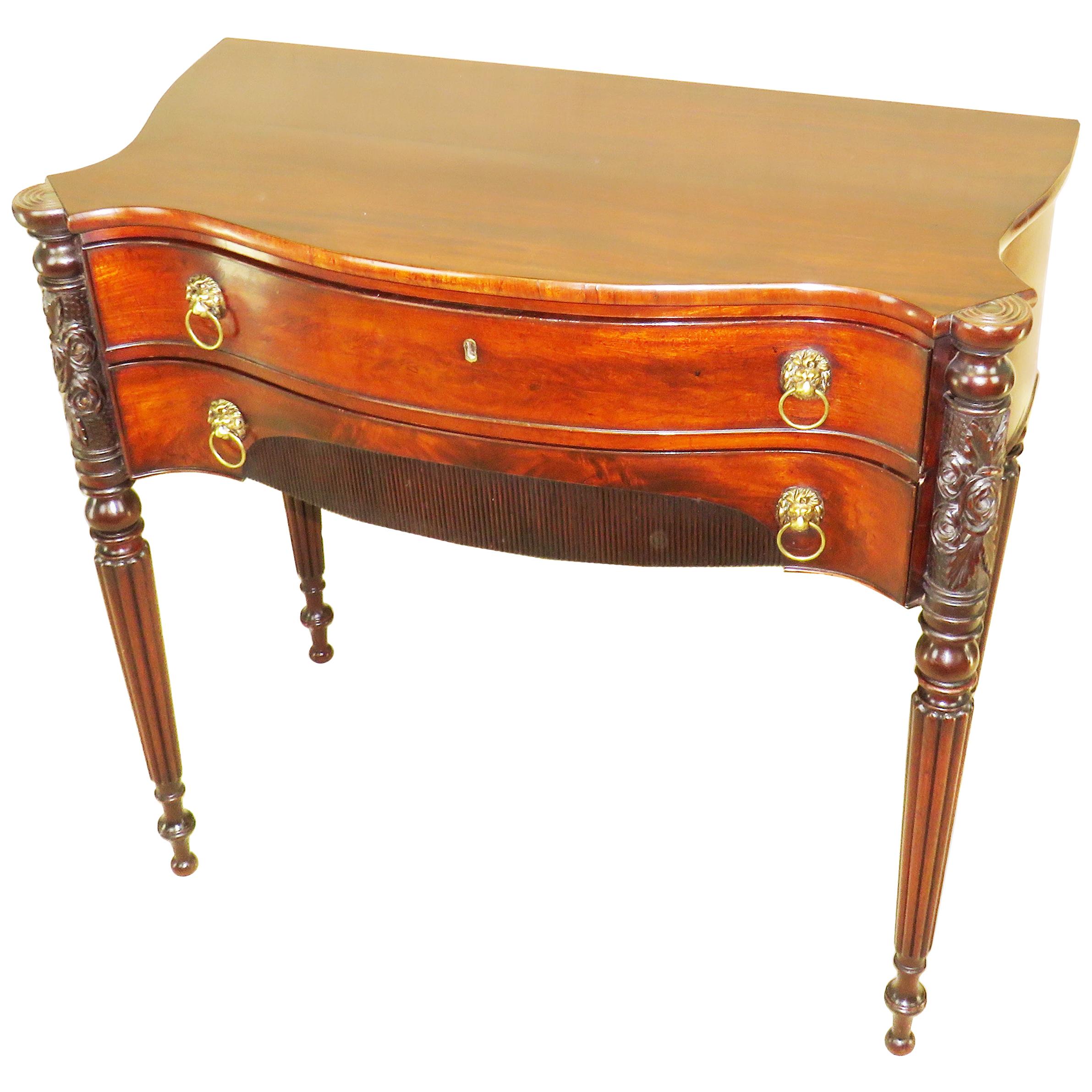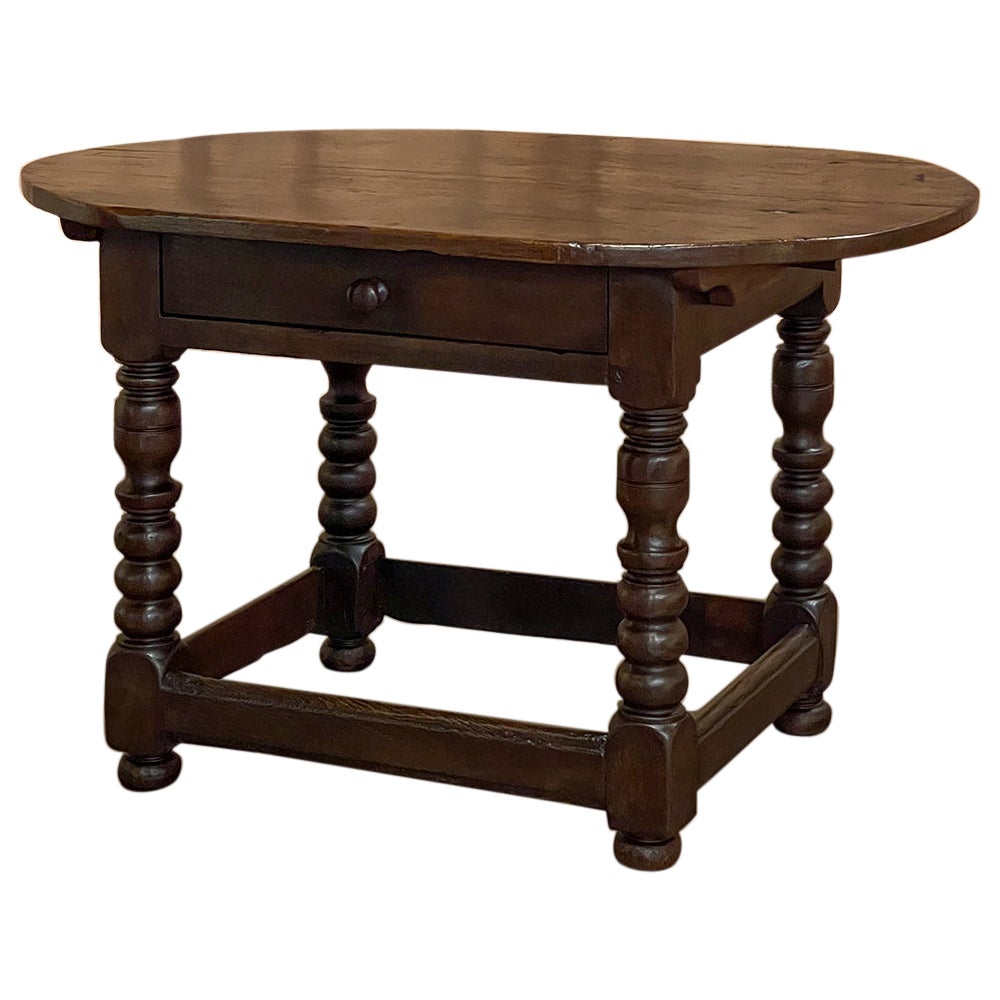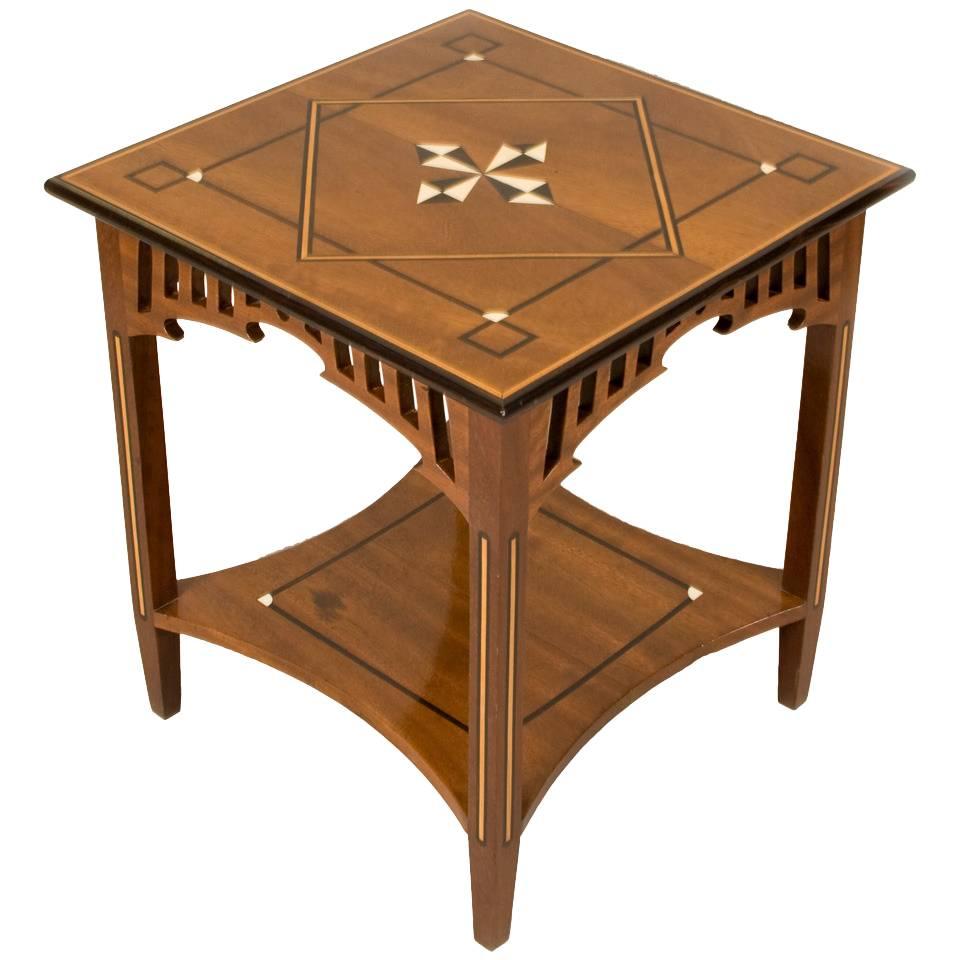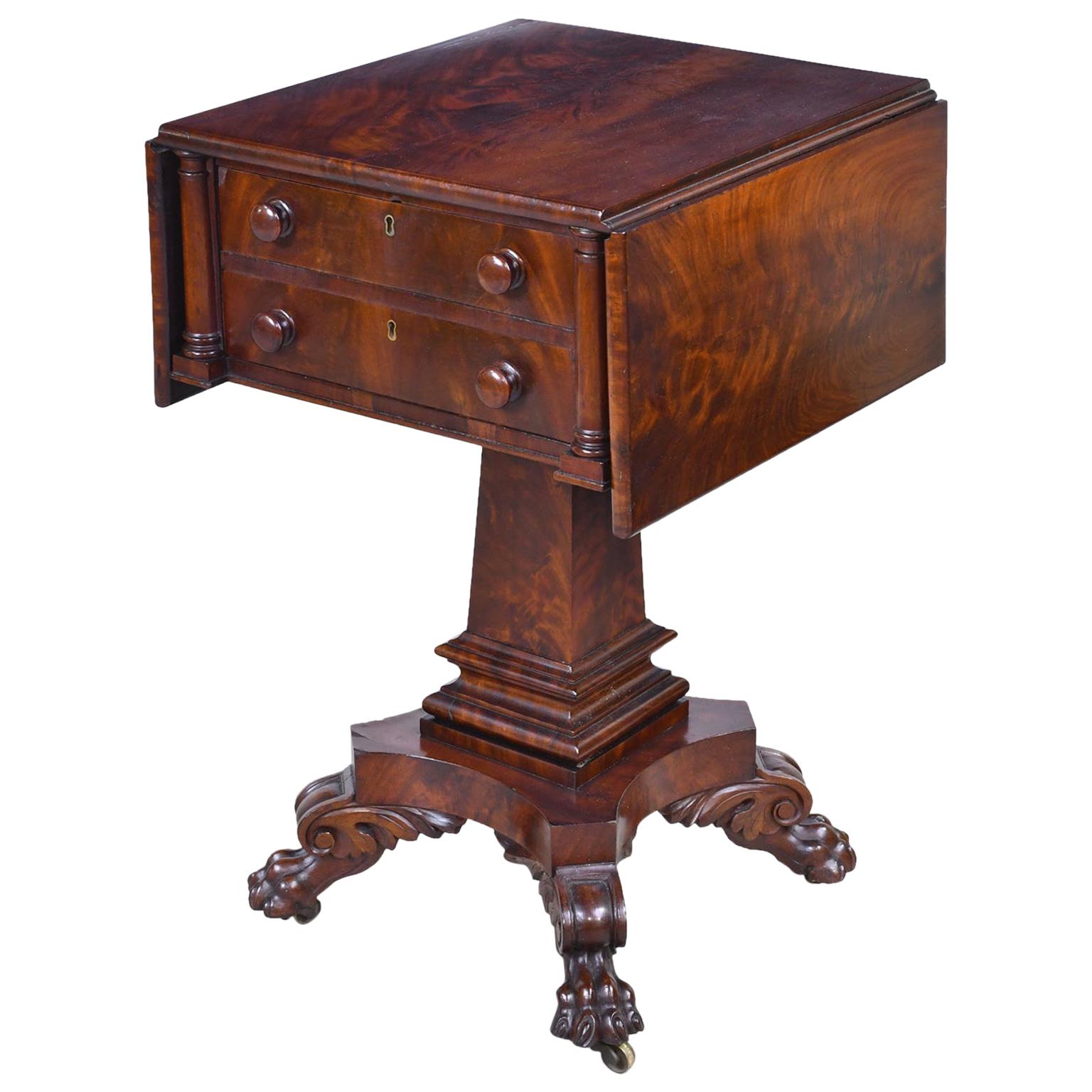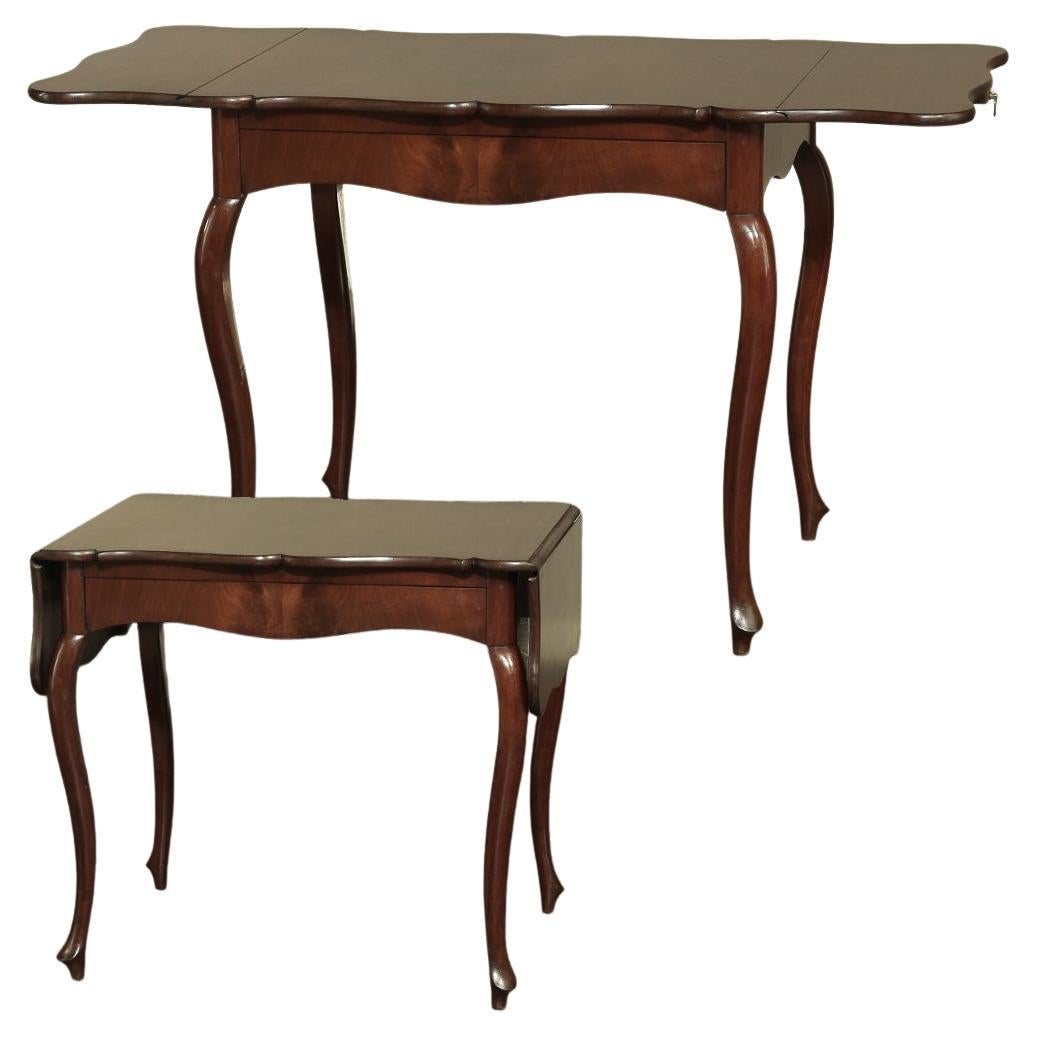Items Similar to Early 19th Century American Federal Period Work Table
Want more images or videos?
Request additional images or videos from the seller
1 of 11
Early 19th Century American Federal Period Work Table
About the Item
A rare and very fine quality classical American Federal period side table / worktable with beautiful, warm rich patina. Circa 1820
Exquisitely hand-crafted in the early 19th century, most likely northeastern or mid-Atlantic region of the United States, the antique table features highest quality mahogany construction, the case fitted with two convex bow front flame mahogany drawers, flanked by scarce and most unusual conforming shaped columns. The original wooden knobs flank brass escutcheons. Rising on finely carved turned barley twist legs terminating in ball feet.
Provenance:
A exceptionally curated Chieftans Rd Greenwich, Connecticut estate
Dimensions: (approx)
28.5" High, 24" Wide, 21.5" Deep
As warm and attractive as it is functional, having the ideal size and proportions for a variety of different uses, including as a end table, bedside cabinet nightstand, hall table, lamp stand or parlor table to name just a few. Wherever it's placed, it's sure to add a touch of refined elegance, understated sophistication and classic warmth to any space.
Great original antique condition with nicely aged patina over the whole. Present splendidly. Solid, sturdy, stable, and structurally sound. Wear and tear consistent with age and use, including minor imperfections such as to the edge of drawer, light rubbing, and key lost to time. Overall a superior example. Delivered cleaned, hand waxed, polished, ready for many, many more years of use.
- Dimensions:Height: 28.5 in (72.39 cm)Width: 24 in (60.96 cm)Depth: 21.5 in (54.61 cm)
- Style:Federal (In the Style Of)
- Materials and Techniques:
- Place of Origin:
- Period:
- Date of Manufacture:circa 1820
- Condition:Wear consistent with age and use. Minor losses. Minor fading. Solid, sturdy, stable, and structurally sound. Wear and tear consistent with age and use, including minor imperfections such as to the edge of drawer, light rubbing, and key lost to time.
- Seller Location:Forney, TX
- Reference Number:1stDibs: LU5977227089612
About the Seller
4.8
Platinum Seller
These expertly vetted sellers are 1stDibs' most experienced sellers and are rated highest by our customers.
Established in 2013
1stDibs seller since 2021
200 sales on 1stDibs
Typical response time: <1 hour
- ShippingRetrieving quote...Ships From: Forney, TX
- Return PolicyA return for this item may be initiated within 7 days of delivery.
More From This SellerView All
- 19th Century French Belle Époque Period Marquetry Tiered TableLocated in Forney, TXA beautiful French La Belle Époque period mahogany inlaid two-tier etagere stand / side table from the second half of the 19th century. Handcrafted with exceptional craftsmanship, elegantly finished in the timeless and classic Louis XV taste, having a shaped top accented by gilt metal rim, breathtaking marquetry and matched inlay, over a scalloped apron embellished with finely detailed sculpted and chisled gilt bronze ormolu mounts, above the conforming shaped medial shelf, all graceful rising on excellent quality ormolu mounted cabriole legs, terminating in gilded bronze sabots. A great presence and good proportions, make this versatile piece the ideal size for use as a accent table, occasional table, whatnots etagere...Category
Antique Late 19th Century European Belle Époque Side Tables
MaterialsBronze, Ormolu
- Primitive 19th Century American Farm Work TableLocated in Forney, TXPrimitive perfection!! A charming antique American pine country farmhouse work table in original red paint. Hand-crafted in the early 19th century, originating in the northeastern Un...Category
Antique Early 19th Century American Country Industrial and Work Tables
MaterialsPine, Paint
- Early American Federal Period Flame Mahogany Antique Wash StandLocated in Forney, TXA rare and stunning Federal period (1789-1823) early American flame mahogany wash stand. circa 1810 Exquisitely hand-crafted in the Northeastern United States in the early 19th cent...Category
Antique Early 19th Century American Federal End Tables
MaterialsBrass
- Early 19th Century English Regency Period Sewing TableLocated in Forney, TXAn elegant Regency period English mahogany and rosewood work table, circa 1815, in the manner of Gillows, having an attractive flame mahogany top with rope trim detail, above a singl...Category
Antique Early 19th Century Regency Side Tables
MaterialsMahogany, Rosewood, Fabric
- 19th C. French Charles X Restoration Period Sewing Stand Work TableLocated in Forney, TXA scarce period Charles X (1818-1834) French Restoration mahogany travailleuse sewing (thread stand - side table - jewelry dressing table) with light, warm, beautifully aged patina. Born in France in the early 19th century, almost certainly Parisian work, exquisitely hand-crafted, this exceptionally executed example features ornate gilt bronze ormolu mounts, escutcheons, and elaborate gilt metal trim. Having a highly figured light mahogany hinged lid top, lifting open to reveal a striking finished interior with divided compartments and original inset mirror plate. The conforming rectangular case fitted with a faux drawer front over a dovetailed drawer with sectioned interior. Elegantly rising on oval-shaped medial shelf stretcher-joined curvacious legs. Dimensions (approx): 27" High, 20" Wide, 13.5" Deep Stunning light almost blonde antique mahogany coloring and mellow warm tone, superb wood grain detail, and charming, beautifully aged patina over the whole. Great shape overall. Retaining original antique character marks, wear consistent with age and indicative of minimal use, nothing that detracts from the aesthetics or functionality, but only adds to the overall authenticity, refined elegant warmth, luxurious sophistication, and cozy unpretentious rustic elegance. Delivered cleaned, hand waxed, polished French patina finish, ready for immediate use and generational enjoyment! What is Charles X style: The comte d’Artois – or Charles X - was the son of the dauphin Louis-Ferdinand de Franc and Marie-Josèphe de Saxe. He succeeded his two brothers Louis XVI and Louis XVIII and became the King of France in 1824. Thirty years after the French Revolution, he wanted to embody the return of monarchy and became the leader of the catholic party . As the previous kings, he was crowned in 1825 but he was soon overthrown by the revolution in July, 1830, called "Trois Glorieuses". He left then for England, Scotland, Prague and Istria where he died in 1836. Charles X style lasted from 1818 to 1834 and happened during the Bourbon Restoration (French Restoration). This style did not replace totally the style of furniture from the French Empire but it was different from the formalism in the Napoleonic era, during which strictness and simplicity were inspired by Greco-Roman art. Indeed, artistic fields flourished. In terms of furniture, this renewal was suggested by the softening of shapes. Even though the simple aspect from the French Empire was still visible, shapes became curvier with volutes and arabesques. Another distinction is the loss of the massive aspect of furniture and the decrease of dimensions in order to decorate smaller appartments. Handling ability and comfort were key-words in the making of furniture. Apartments had essential elements such as chests of drawers, big rounded tables in the dining room, desks or secretaries, armoires and even dressing tables, comfortable fainting couches in the living room, small tables, pedestal tables, as well as gondola chairs. The wavy aspect of the latters certainly represent Charles X style the best. One of the most emblematic features of this style is the use of bois clairs – light woods in warm blond tones - and indigenous woods that are varnished in order to highlight the grains. Bird's-eye maple, ash trees, plane trees, yew trees, beech trees, olive trees and cedar trees were most likely to be used. Indeed, at the beginning of the 19th century dark woods were hard to find. In 1806, the Napoleon’s Continental System was established in order to ruin the United Kingdom by preventing the country from any business with the rest of Europe. Therefore craftsmen had to find alternatives from mahogany which was the most commonly used material at this time. After 1815, the import of wood was even more difficult because of peace treaties and the European political situation, which contributed to the popularity of the bois clairs and indigenous woods. The furniture was often decorated with fine inlays made out of dark wood representing foliage, which contrasted with the veneer. Even though these patterns can look like bronze decorations from the Empire era, they were far more simple and did not represent any military or mythological attributes. On the tables, trays were sometimes made out of marble as in the French Empire, but it was often put aside and inlaid veneer, Verre Eglomisé – a type of glass with a mirror finish –, mirror or porcelain from Sèvres or Paris were more likely to be used. Decorative elements from the Monarchy were highly appreciated again as they suggested luxury. Indeed, marquetry work was particularly fashionable - Boulle marquetry thrived around 1820 as the works of the Levasseur family can show. In the same way, draperies and trimmings referred to the monarchist splendour. Fabrics were often white – the traditional colour of the Bourbons – or light coloured as oppposed to the typical green from the Napoleonic era. One of the most symbolic figures from this period of time might be Jean-Jacques Werner (1791-1849), a cabinetmaker who worked for prestigious clients such as the Duchesse de Berry who was Charles’s step-daughter. His works can be seen at the Musée des Arts Décoratifs and at the Grand Trianon in the Palace of Versailles. The duchess’s appartments situated at the pavillon de Marsan and at the Palais de Saint Cloud illustrate Charles X style the best with furniture made out of bois clairs and ornamented with dark wood patterns or fine gold decorations. Chales X style allows a transition between the sobriety of the Empire style and the abundant aspect of Louis-Philippe style. The gothic style started at this time through the "style à la cathédrale", inspired by religious architecture, which thrived from 1827 to 1830. Indeed, at the beginning of the 19th century, Romanticism put the spotlight on the Middle Ages. Cabinetmakers were not inspired by the medieval furniture but rather by architectural elements of churches and cathedrals. For instance the backs of chairs were decorated with arches shaped like rib and serration. In the same way, before Charles X abdicated, pieces of furniture were made out of dark woods – such as mahogany, which was used again in France – and were inlaid with light wood. Romanticism also influenced the layout of furniture in appartments to suggest movement through a mix of various styles, various shapes and various sizes, as opposed to the static aspect of Neoclassicism. The start of industrialisation and mechanisation also influenced this style as early technical developments led to the production of pieces of furniture in series. Credit: Marc Maison Bibliography: FANIEL Stéphane (Dir.), Le Dix-neuvième Siècle Français, Collection Connaissance des Arts, 1957, Hachette SASSONE, Adriana Boidi, Furniture from Rococo to Art Deco, 2000, Evergreen -- Extremely versatile: As warm and attractive as it is useful, this remarkable antique table having the ideal size and small proportions for a variety of different uses, including as a side table, accent or occasional table, tall sofa...Category
Antique Early 19th Century French Charles X End Tables
MaterialsBronze, Ormolu
- 19th Century Escalier de Cristal French Louis XV Side TableBy L'Escalier de CristalLocated in Forney, TXA gorgeous antique Louis XV style side table by Escalier de Cristal with beautiful patina. Hand crafted in Paris France during the last quarter of the 19th century, it features a verde marble-top, above a diamond motif parquet case with a single drawer, opposing side having a pull-out serving tray slide with green inset gilt-tooled leather panel, long slender cabriole legs with beautiful exotic wood inlay floral medallions, medial shelf with checkerboard motif parquetry and cross-banded border, ending with decorative gilt-bronze accented feet. Signed Escalier De Cristal Paris Dimensions: (approx) 29" H, 14.5" W, 14.5 D Great antique condition. Original, unrestored, antique condition. Having patina. Missing one gilt foot accent. Some loss. Wear/tear consistent with age and use. Provenance: From the estate of Lonnie Alfred "Bo" Pilgrim (May 8, 1928 – July 21, 2017) co-founder of Pilgrim's Pride, which at one time was one of the largest chicken producers in the United States. Pilgrim co-founded Pilgrim's Pride when he opened a feed store...Category
Antique 19th Century French Louis XV End Tables
MaterialsMarble, Bronze
You May Also Like
- 19th century Regency Rosewood Work TableLocated in Savannah, GARosewood work table featuring concave sides and front, a brass base cap, brass bun feet and turned rosettes on the top of the feet. The work basket has been replaced with pleated sil...Category
Antique Early 1800s English Regency Side Tables
MaterialsBrass
- American 19th Century Federal Mahogany Serpentine TableBy Samuel Field McIntireLocated in Bedfordshire, GBA superb quality and extremely rare early 19th century American federal period mahogany dressing table of serpentine form having well figured top over two frieze drawers retaining original lions mask brass handles raised on elegant carved and reeded turned tapering legs Attributed to “Samuel Field McIntire, Salem, Massachusetts’ (Samuel Field McIntire who worked in Salem, at the start of the early 19th century was the son of Samuel McIntire...Category
Antique Early 19th Century American Federal Side Tables
MaterialsMahogany
- Early 19th Century Dutch End TableLocated in Dallas, TXEarly 19th century Dutch end table was fashioned from solid planks of old-growth oak to literally last for centuries! The thick plank top fea...Category
Antique Early 19th Century Dutch Rustic End Tables
MaterialsOak
- 19th Century American Craftsman Walnut Side TableLocated in San Francisco, CAThis beautiful Green and Green style craftsman side table is in very good condition considering it's age. The inlay is ebony wood, bone and satin wood ...Category
Antique 19th Century American American Craftsman Side Tables
MaterialsBone, Ebony, Walnut
- Antique Federal Mahogany Work Table/ Nightstand Attributed to Isaac Vose, BostonBy Isaac VoseLocated in Miami, FLA very handsome Federal work table in fine West Indies mahogany with fold-down leaves. There are two drawers with two rounded columns flanking each side. Drawers have the original turned pulls. Top rests on a square column that gradually widens ending with ogee moldings and rests on quatre-form base with concave arches. Table rests on foliate-carved scrolls that end in carved lions' paw feet with original porcelain casters. Attributed to highly regarded cabinetmaker, Isaac Vose...Category
Antique 1820s American Federal End Tables
MaterialsMahogany
- 19th Century Federal Drop Leaf Table. American, circa 1825Located in Incline Village, NVNicely proportioned and well made early 19th century American mahogany drop leaf table with no restorations and in completely origina...Category
Antique Early 19th Century American Federal Drop-leaf and Pembroke Tables
MaterialsMahogany
Recently Viewed
View AllMore Ways To Browse
Early American Table
Antique Work Table 19th Century
Antique Bedside Table Bedside Tables
Antique Bedside Tables Bedside Tables
Antique Bedside Tables Tables
Antique Bedside Tables Furniture
Antique Bedside Tables Antique Furniture
Antique Bedside Table Furniture
Rising Table
Classical Table American
American Two Drawer
19th Century Bedside Table
Classical Table Light
Antique Cabinet Nightstand
Antique High End Tables
Early American Drawers
Early American Work Table
19th Century American Federal
